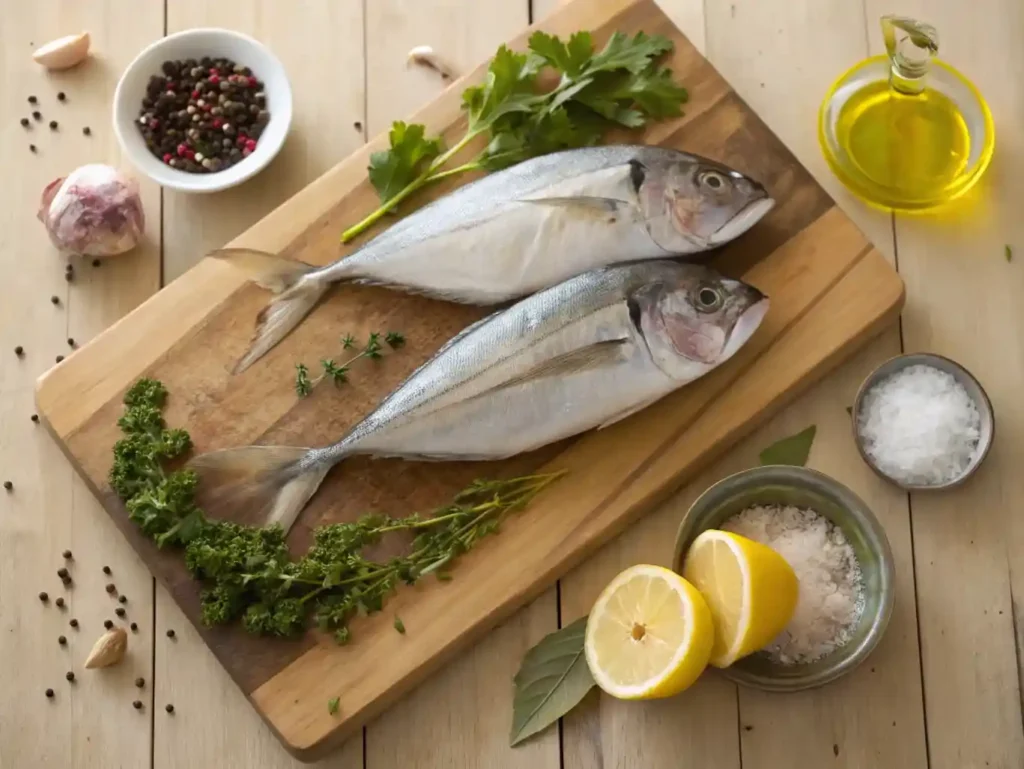Amberjack Fish grilled to perfection has never been easier—discover how to marinate Amberjack Fish in a tangy citrus blend and finish with mouthwatering barbecue flavors. Whether you’re a seafood lover hunting the best Amberjack Fish recipe or aiming to master lemon butter tacos, this guide walks you through every step from preheating the grill to serving irresistible results.
Table of Contents
Amberjack Fish Ultimate Choice for Perfect Grilling
Amberjack Fish is prized for its firm, steak‑like flesh and clean flavor that stands up to high‑heat cooking. Unlike more delicate white fish varieties, this species delivers a satisfying bite and resists flaking when grilled, making it a top pick for any seafood lover.
Amberjack Fish’s moderate fat content and tight grain allow you to use barbecue techniques without losing moisture, achieving a nice char on the sides of the fish and enhancing its natural flavor. Plus, its robust profile makes it ideal for both simple salt and pepper seasoning and more adventurous sauces.
Essential Ingredients to Prepare Amberjack Fish

To nail the best amberjack recipe, gather fresh amberjack fillets (about 6 oz per person) that are firm and translucent. You’ll also need:
- Butter recipe components: 4 Tbsp softened butter, 1 Tbsp minced parsley, and fresh lemon juice from half a lemon.
- Seasoning staples: 1 tsp black pepper, 1 tsp garlic powder, and 1 tsp salt and pepper blend.
- Aromatics: 1 clove pressed garlic, 1 sprig fresh thyme, and 1 tsp red wine vinegar for brightness.
- Finishing touches: a handful of chopped cilantro and a lemon wedge for garnish.
These ingredients form the backbone of your grill‑ready marinade and lemon butter amberjack fish glaze—ensuring each filet is well‑seasoned, juicy, and infused with citrusy depth.
How to Cook Amberjack Fish: A Step-by-Step Guide

- Prep & Marinate
- Pat your amberjack filets dry and place them in a shallow dish.
- Whisk together olive oil, lemon juice, pressed garlic, vinegar, and a pinch of black pepper. Sprinkle in garlic powder and fresh thyme, then add cilantro.
- Coat each filet evenly, cover, and marinate in the fridge for at least 30 minutes.
- Preheat & Sear
- Preheat your grill rack or a heavy pan on medium heat. Lightly spray with cooking spray.
- Remove filets from the marinade, shake off excess, then sear skin‑side down for about 3-4 minutes until you get a nice char.
- Butter Glaze & Finish
- Flip filets, then dollop on the compound butter recipe, letting it melt into the flesh.
- Cook another 3-4 minutes until the fish flakes easily when tested with a fork—but is still moist.
- Transfer to a baking dish or plate, squeeze a bit more fresh lemon juice over the top, and garnish with a lemon wedge and cilantro sprig.
These steps ensure your cooking fresh amberjack locks in flavor without letting the fish overcook. Now you’re primed to tackle the rest of the article’s techniques—from blackening to tacos!
Mastering a Grilled Amberjack Recipe:
Butter Glaze and Broil Techniques
Start with a simple butter recipe that combines softened butter, minced parsley, and fresh lemon juice. Spread this compound butter evenly across each portion of amberjack, making sure to get into every crevice of the flesh. Place each piece onto a hot pan on the grill to melt and seal in flavor. Then finish with a squeeze of lemon juice before serving.
Maintain medium heat so the fish cooks evenly, allowing about 6 minutes of contact before carefully flipping. Monitor closely to prevent overcook, since amberjack’s lean flesh can dry out. When done, the filet should be opaque, flaky yet moist to the touch.
Sear or Blacken Amber Jack Steaks on a Grill Rack?
Start with 1‑inch‑thick amber jack steaks rubbed with your favorite dry rub and let them rest briefly. Heat a cast‑iron skillet until smoking, then set it over glowing coals for maximum heat transfer. Aim for about 3‑4 minutes of crust formation before flipping for even cooking.
After flipping, cook for a similar duration, about the same minutes on each side to ensure uniform doneness. Use a timer to track minutes per side if you’re aiming for consistency. Test the thickest part by pressing gently or tested with a fork; the flesh should yield easily but not fall apart. This approach yields firm amber jack steaks with just enough char to complement its richness.
Japanese Twist: Amberjack fish with Shiso, Teriyaki, and Buri Techniques
This regional style highlights shiso leaves layered beneath each slice, introducing a bright herbal edge. For a quick variation, substitute rice vinegar and a touch of sugar to mimic a sweeter profile.
Some recipes begin by caramelizing the edges over hot charcoal, which locks in juices and accentuates the fish’s natural oils. Paired with a side of pickled cucumber, this approach brings together texture and tang in every bite.
Comparing Seafood Recipes: Amberjack vs Yellowtail and Grouper
Amberjack’s firm texture sits between that of delicate yellowtail and mild grouper, giving it a meaty feel without crossing into the overly fatty category. While yellowtail offers a buttery mouthfeel and grouper tends to flake apart, amberjack provides the best of both worlds for creative cooks.
In many seafood recipes, tilapia or cod serve as cost‑effective alternatives, though they lack amberjack’s resilience under heat. Adjust cooking time downward for tilapia, while allowing cod more time to develop flavor without drying out.
How to Make Crispy Amberjack Filets for Amberjack Fish Tacos
To achieve a crispy finish, dust the fish with a light coating of cornmeal and garlic powder, shaking off any excess. Heat oil in a skillet until shimmering, then fry the amberjack fish filets until golden brown on the bottom of the pan.
Warm your tortilla on a dry griddle and fill each taco with slices of the crispy filet. Top with pineapple mango salsa and thinly sliced red onion for brightness, adding a few chopped jalapeños or a single jalapeño ring if you like heat. Serve immediately to preserve the crunch.
Zesty Marinades: Lemon, Lime Juice, and Vinegar Combinations
Combine citrus juice with rice vinegar, a drizzle of oil, and aromatics for a quick zing. The acidity helps break down proteins and infuse flavor deep into the flesh. Try adding a dash of red wine vinegar to balance sweetness and brightness.
Before placing the fish on hot grates, remove it from the marinade and pat the surface dry to prevent flare‑ups.
Cooking Fresh Amberjack: Avoiding Overcook and Common Mistakes
When cooking fresh amberjack, start with room‑temperature portions and pat them dry to encourage even browning. Too high a flame can cause the exterior to char before the center cooks, so lower heat if needed to maintain gentle cooking.
Avoid overcook by watching the fish closely—the lean flesh will change from translucent to opaque rapidly. Prevent sticking by applying a light coat of cooking spray to your pan. As the fish nears completion, fish flakes easily when tested, signaling it’s time to remove and rest briefly before serving.
Serving Suggestions: Succotash, Sautéed Broccoli, and Creole Cajun Garnish
Pair with a vibrant succotash of corn, tomatoes, and beans tossed with diced red pepper for a pop of color.
For a lighter side, prepare broccoli sautéed in olive oil with a clove of garlic and a hint of salt before finishing with a wedge of lemon.
Garnish your plate with a drizzle of Creole mustard sauce or a sprinkle of Cajun spice to tie all flavors together.
FAQs
What does Amberjack Fish fillet taste like?
Amberjack Fish fillets offer a firm, meaty texture with a mild, slightly sweet flavor—akin to yellowtail or kingfish. Their dense white flesh holds up beautifully to marinades like lemon butter and blackened seasonings without falling apart.
Can you eat large Amberjack Fish?
Yes, you can eat large Amberjack Fish, but be mindful that bigger, older fish can accumulate higher levels of mercury and may even carry ciguatera toxins in tropical regions. It’s safest to target medium‑sized catches (under 20 lbs) and rotate with other seafood choices.
What is the best way to catch Amberjack Fish?
The most effective way to catch Amberjack Fish is with heavy tackle around offshore wrecks or reefs. Use a stout rod, braided line, and circle hooks baited with live mackerel or bonito. Jigging dozens of feet down along structure at depths of 60–200 ft often yields the best results.
What is Amberjack Fish also known as?
Amberjack Fish—especially the greater amberjack (Seriola dumerili)—is also called reef donkey, yellowtail, or buri in Japan. Other related species in the Seriola genus go by names like almaco jack and skipjack amberjack.
What are the benefits of Amberjack Fish?
Amberjack Fish is a lean source of high‑quality protein, rich in omega‑3 fatty acids, vitamin B12, selenium, and phosphorus. Regularly enjoying Amberjack Fish supports heart health, helps reduce inflammation, and promotes healthy brain function.

Grilling the Ultimate Amberjack Fish Tacos with Lemon
Ingredients
Butter recipe components:
- 4 Tbsp softened butter 1 Tbsp minced parsley, and fresh lemon juice from half a lemon.
Seasoning staples:
- 1 tsp black pepper 1 tsp garlic powder, and 1 tsp salt and pepper blend.
Aromatics:
- 1 clove pressed garlic 1 sprig fresh thyme, and 1 tsp red wine vinegar for brightness.
Finishing touches:
- a handful of chopped cilantro and a lemon wedge for garnish.
Instructions
Prep & Marinate
- Pat your amberjack filets dry and place them in a shallow dish.
- Whisk together olive oil, lemon juice, pressed garlic, vinegar, and a pinch of black pepper. Sprinkle in garlic powder and fresh thyme, then add cilantro.
- Coat each filet evenly, cover, and marinate in the fridge for at least 30 minutes.
Preheat & Sear
- Preheat your grill rack or a heavy pan on medium heat. Lightly spray with cooking spray.
- Remove filets from the marinade, shake off excess, then sear skin‑side down for about 3-4 minutes until you get a nice char.
Butter Glaze & Finish
- Flip filets, then dollop on the compound butter recipe, letting it melt into the flesh.
- Cook another 3-4 minutes until the fish flakes easily when tested with a fork—but is still moist.
- Transfer to a baking dish or plate, squeeze a bit more fresh lemon juice over the top, and garnish with a lemon wedge and cilantro sprig.
Notes
Nutrition Information (per serving)
| Nutrient | Amount |
|---|---|
| Calories | 350 kcal |
| Total Fat | 18 g |
| – Saturated Fat | 8 g |
| Cholesterol | 120 mg |
| Sodium | 400 mg |
| Carbohydrates | 1 g |
| – Fiber | 0 g |
| – Sugars | 0 g |
| Protein | 50 g |
Categorization
- Course: Main Course
- Cuisine: Seafood
- Diet: Pescatarian
- Method: Grilling
- Keyword: Amberjack Fish
- Skill Level: Intermediate











